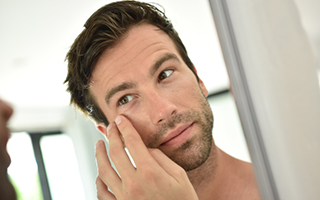One of the questions we often get from patients who are searching for cosmetic treatments for facial rejuvenation is, “Do fillers help dark undereye circles?” Our Bryn Mawr-based practice can provide fillers for the eye area that restore volume, thereby decreasing the darkness, while still making results look as natural as possible.
While the eyes are considered by many to be the “windows to the soul,” the skin around them reveals even more about you. When you’re sleep deprived, it’s common to notice dark circles and more swelling or puffiness around the eyes. In addition to sleep problems, more factors—including dehydration, weight loss, smoking, sun damage, and collagen loss due to aging—are some of the other common causes of sunken areas under the eyes, also known as tear trough hollows. These hollows often look more prominent on thin faces where there is less fat below the eyes. Thin and delicate undereye skin is more prone to showing signs of aging.
In the past, it was difficult to disguise undereye hollows, but there are some new innovative treatments that make it easier than ever to soften them. Although there are many fillers available to treat tear trough areas, hyaluronic acid fillers like Restylane®, Belotero® and RHA-2® are ideal for correcting undereye shadows because they integrate easily into the thin, delicate skin and produce natural-looking results.
Interested in using less concealer and makeup to hide undereye circles? Hyaluronic acid fillers quickly restore volume to the tear trough area to create a younger, brighter, and more balanced appearance for the face while also minimizing wrinkles and reducing darkness below the eyes.
If you’re looking for an answer for the question “Do fillers help undereye circles?” our Bryn Mawr-based team can provide answers and address any other concerns you might have about facial fillers. Contact our Cirillo Cosmetic Dermatology Spa team directly by calling 610.525.5029 or submit a contact form to request a consultation and get to know more about these cosmetic treatments.


-updt.png)





















